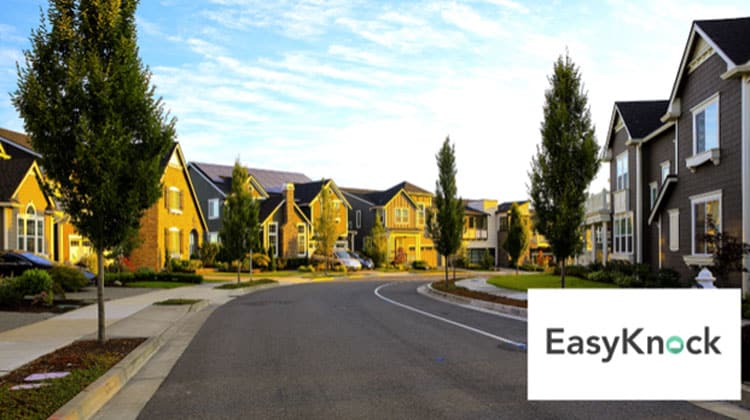EasyKnock CEO Jarred Kessler on How Sale-Leasebacks Can Ease Homeowner Stress in a Frozen Housing Market

Property transactions in the U.S. housing market are at their lowest point in decades, with just 2.5% of homes changing hands in the first eight months of the year. This marks the lowest turnover rate in at least 30 years, according to an analysis by the online real estate brokerage Redfin. Despite the Federal Reserve’s recent rate cuts, the combination of record-high home prices and elevated mortgage rates has created one of the most unaffordable housing markets in a generation, leaving many homeowners feeling trapped and unable to access their home equity.
In this challenging environment, alternative solutions like sale-leasebacks are gaining attention. Jarred Kessler, CEO of EasyKnock, a company specializing in residential sale-leaseback solutions, believes that such alternatives can provide much-needed flexibility for struggling homeowners, many of whom have accumulated debt but do not qualify for loan solutions.
“The system has the right intentions,” said Kessler in a recent interview, referring to post-2008 lending regulations. “But one of the big reasons people get declined is due to their debt-to-income ratio. Around 70% of homeowners in the country don’t have proper access to the mortgage markets, and it’s one of the big reasons you don’t see a lot of movement.”
A Frozen Housing Market
The current housing market’s sluggishness is stark when compared to recent years. Redfin’s data shows that 37% fewer homes were sold between January and August this year than during the same period in 2021, which saw a pandemic-induced burst of home-buying activity. Even compared to prepandemic levels, the market has cooled significantly, with 31% fewer homes sold than during the same period in 2019.
Chen Zhao, Redfin’s economic research lead, put the current situation into perspective in an interview with CNN: “What this data tells us is that the housing market in 2024 has been really frozen. We said the same thing in 2023 and I think there was this expectation that it couldn’t get any worse, but 2024 has been disappointing for the housing market.”
Kessler notes, “It’s hard to believe that people have this much equity and yet are limited in how they can access it. You often hear that your home is not an ATM, but if your home has assets and you are struggling, convert it into cash and pay off that high-rate debt. Why shouldn’t there be choices for people?”
The ‘Lock-In Effect’ and Housing Shortage
A major factor behind the housing market’s stagnation is what economists term the “lock-in effect.”
“There has been very little incentive for people to sell homes,” said Zhao. “That very low inventory on the market was one of the primary drivers of there being so little turnover.”
A significant portion of American homeowners secured mortgages at historically low interest rates before 2022. These individuals are now reluctant or unable to sell their properties, as doing so would likely mean purchasing a new home at a much higher interest rate. The Consumer Financial Protection Bureau reports that nearly 60% of the 50.8 million active mortgages have interest rates below 4%.
Compounding this issue is a shortage of new housing construction. Industry experts estimate that over 2 million additional homes need to be built to meet current demand. This supply deficit has contributed to record-breaking home prices. According to the National Association of Realtors, the median price for an existing home in August stood at $416,700, marking the 14th consecutive month of year-over-year increases.
Sale-Leasebacks as an Alternative Solution
In this daunting market, alternative approaches like sale-leasebacks are gaining traction. EasyKnock offers homeowners the option to sell their properties while continuing to live in them as renters, allowing them to convert the home equity they have accumulated through rising home prices without the need to relocate.
Kessler stresses the importance of providing options, particularly for middle-class homeowners who, despite the increasing value of their homes, have been forced to take on debt in an inflationary economy in recent years.
“When you’re rich, there’s a lot of choices, and when you’re in the middle class, there’s not a lot of choices,” says Kessler. “The people that need the choices the most are the people that are dealing with inflation, that are trying to figure out how to deal with that unexpected bill of a few hundred dollars or more.
“More options should be in the market and the people that need the options the most are the middle class and below,” he continues. “Those are the people that need the most options and those are the people that have the highest cost in their lives.”
The Mechanics of Sale-Leasebacks
EasyKnock’s sale-leaseback program allows homeowners to sell their properties to the company and then lease them back, for up to five years. This arrangement immediately converts homeowners’ equity to cash while enabling them to stay in their homes.
Kessler outlines several advantages: “You don’t have to pay a real estate broker. When we buy the home, we take a fee, there’s no staging, no open houses with people coming in and out of your home, you get rid of the taxes, homeowners insurance, and HOA, and you still get cash out and you still get the ability to get all the upside if the house goes up in value.”
Notably, EasyKnock has pledged to limit annual rent increases to the greater of 2.5% or the consumer price index. This policy aims to provide stability for homeowners turned renters, especially in a market where some landlords have implemented substantial rent hikes.
“We basically made a call for other landlords to do it. It’s the greater of 2.5% or CPI,” says Kessler. “The Biden administration asked for a cap of 5%. They didn’t put inflation in there, but I think if you want to be fair and balanced, that’s the way to do it.”
Tackling Affordability Issues
The challenge of housing affordability extends beyond homeowners to the rental market as well. Kessler believes that an unexpected $500 expense would be devastating for most Americans, who continue to live paycheck to paycheck.
He advocates for increased collaboration between government and private sector entities to address these speed bumps: “I think the more folks in the government and the private sector partner up, I think the better things can become. And I think that’s one of the things that could actually really change the landscape of the housing market.”
While sale-leasebacks offer a potential solution for some homeowners, experts agree that addressing the broader issues in the housing market will require significant effort and time.
Zhao estimates that it could take between five and 10 years for the housing market to return to a state resembling past norms.
“Getting to a healthy housing market is very hard from this point,” she said. “I think the answer is either some variation of, you need a huge amount of supply to come on, whether that’s new construction, or whether we somehow unlock existing homeowners.”
Have you read?
Why You’ll Never Close the Strategy-to-Execution Gap (Unless You Do This).
Meetings Are the #1 Killer of Productivity.
Amazon CEO says RTO, or Else! – Is Remote Work Dead?
The 5 skills entrepreneurs need to succeed in 2025.
Global Health Partners Commit Over $345 Million for WHO’s Future Initiatives.
Bring the best of the CEOWORLD magazine's global journalism to audiences in the United States and around the world. - Add CEOWORLD magazine to your Google News feed.
Follow CEOWORLD magazine headlines on: Google News, LinkedIn, Twitter, and Facebook.
Copyright 2025 The CEOWORLD magazine. All rights reserved. This material (and any extract from it) must not be copied, redistributed or placed on any website, without CEOWORLD magazine' prior written consent. For media queries, please contact: info@ceoworld.biz








